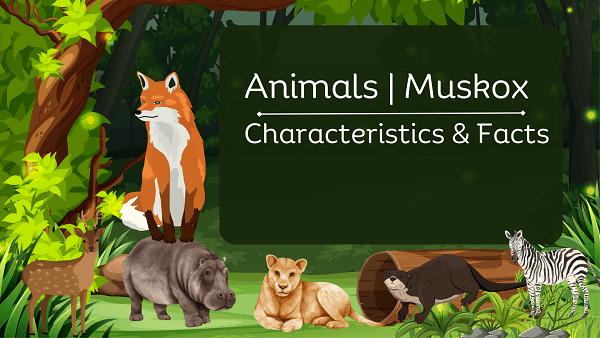Muskox Definition | Characteristics & Facts
Home » Animals » Muskox Definition | Characteristics & Facts

Muskox Definition
A muskox (scientific name: Ovibos moschatus) is a large, stocky mammal that belongs to the Bovidae family. It is native to the Arctic regions of North America and Greenland.
Muskox General Characteristics & Facts
Range and Habitat
The correct spelling is “muskox” as one word, not “musk ox” as two separate words.
Social Structure
Muskoxen are herd animals and live in groups. The herds typically consist of females, their offspring, and sometimes a dominant male. During the mating season, dominant males may form temporary bachelor groups. The females often form close-knit family units.
Reproduction
Muskoxen have a long gestation period, lasting about eight to nine months. Calves are born in the spring, typically from late April to early June. Newborn calves are incredibly cute and covered in a soft, reddish-brown coat, contrasting with the darker color of the adults.
Diet
As herbivores, mukoxen primarily graze on grasses, sedges, willow leaves, mosses, and lichens. Their unique digestive system allows them to extract nutrients from the tough and fibrous Arctic vegetation.
Predators
Muskoxen face threats from predators such as Arctic wolves and polar bears. As a defense mechanism, they form a tight circle, facing outward, when threatened, which makes it challenging for predators to penetrate their protective ring.
Conservation Status
The muskox population declined significantly due to overhunting and habitat destruction in the past. However, conservation efforts have helped stabilize their numbers, and today, they are listed as a species of “Least Concern” by the International Union for Conservation of Nature (IUCN). Nonetheless, they are still vulnerable to climate change and other environmental factors affecting their Arctic habitats.
Cultural Significance
Muskoxen have cultural significance for indigenous communities living in the Arctic. They provide food, clothing, and materials for various traditional purposes, and their presence is deeply intertwined with the heritage and customs of these cultures.
Read our Animals Encyclopedia with Complete Facts
Physical Characteristics Muskox
- Thick Double-Layered Coat: One of the most notable features of muskoxen is their dense, double-layered coat. The outer layer consists of long, coarse guard hairs that provide protection against the harsh Arctic winds and snow. Underneath, they have a soft, insulating undercoat made of qiviut, a fine and warm wool. This combination of hairs helps them maintain body heat and stay warm in extremely cold temperatures.
- Large, Curved Horns: Both males and females have large, curved horns that grow out of their skulls. The horns are more massive in males and can weigh up to 50 pounds (22.7 kilograms). They form a continuous shield-like structure known as a “boss” over the forehead of mature males. Female horns are smaller and more slender but still serve as effective defense tools.
- Stocky Build: Muskoxen have a robust and heavily built physique. They have a humped shoulder, short, thick neck, and a sturdy body, all of which contribute to their ability to endure the challenging Arctic conditions.
- Dark Coloration: Their coat can vary in color, but muskoxen are generally dark brown to black in appearance, providing them with good camouflage in their natural habitat.
- Short Legs: Muskoxen have relatively short legs, which help them conserve energy while moving through deep snow and navigating uneven terrain.
- Musk Glands: Both males and females have musk glands located near their eyes, which secrete a strong-smelling musky substance. These glands are more prominent in males and play a role in communication and mating behavior.
- Shoulder Hump: Muskoxen have a prominent hump on their shoulders, which contains a large mass of muscle used for digging through the snow to access vegetation in winter.
- Lifespan: In the wild, muskoxen have an average lifespan of around 12-20 years. In captivity, they can live longer, up to 20-25 years.
Continue To Explore All Animals That Start With M
Scientific Classification of Muskox
Kingdom: Animalia (Animals)
Phylum: Chordata (Chordates)
Class: Mammalia (Mammals)
Order: Artiodactyla (Even-toed ungulates)
Family: Bovidae (Cattle, antelopes, and relatives)
Subfamily: Caprinae (Goats and sheep)
Genus: Ovibos
Key Locations of Muskox
- Arctic regions of Canada
- Arctic regions of Alaska, United States
- Greenland
- Arctic regions of Russia
- Arctic regions of Norway
- Arctic regions of Sweden
- Arctic regions of Finland
- Grasses
- Sedges
- Willow Leaves
- Mosses and Lichens
- Arctic Flowers


